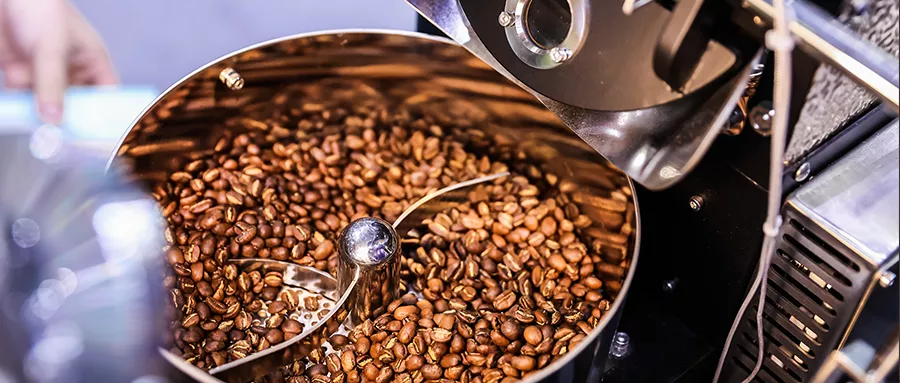In the coffee roasting process, hot air control is one of the core factors affecting roasting uniformity, flavor development, and roasting efficiency. The hot air system directly influences the dehydration of coffee beans, chemical reactions, and final quality by regulating temperature, airflow velocity, and pressure. Below is a detailed analysis and practical guide to hot air control:
I. Role of Hot Air in Roasting
1. Heat Transfer Mechanisms
Convection Heating: Hot air directly contacts the bean surface, rapidly transferring heat (accounting for over 70% of heat transfer, especially in the initial stages).
– Indirect Conduction: Hot air circulation reduces cold spots on the roaster’s metal components, indirectly promoting heat penetration into the bean core.
2. Key Functions
– Dehydration: Removes moisture from green beans (reducing from 12-13% to 1-2% moisture content).
– Chemical Reaction Control: Regulates the rates of Maillard reactions and caramelization.
– **Smoke and Chaff Removal: Carries away surface debris and volatile compounds to avoid burnt flavors.
—
-II. Stage-Specific Hot Air Control Strategies
1. Preheating Stage
– Objective: Establish a stable thermal environment to prevent uneven roasting due to a “cold start.”
– Recommended Parameters:
– Hot air temperature: 180–220°C (adjust based on roaster capacity).
– Damper opening: 30–50% (ensure airflow circulation without excessive heat loss).
– Critical Note: Insufficient preheating may slow initial temperature rise, extending total roast time.
2. Dehydration Stage (0°C → 150°C)
– Hot Air Requirements: Medium-high temperature, high airflow.
– Temperature: 200–230°C (avoid excessive heat causing surface scorching).
– Damper: 60–80% (accelerate moisture evaporation and prevent overheating at the bean pile’s base).
– Risk Management: Excessively dry hot air may worsen uneven dehydration; monitor the Turning Point (TP) slope.
3. Maillard Reaction & Caramelization Stage (150°C → Pre-First Crack)
– Hot Air Adjustments:
– Temperature: Gradually reduce to 190–210°C (slow surface hardening and promote internal development).
– Damper: Lower to 40–60% (retain thermal energy to extend reaction time).
– Scientific Basis: Reduced airflow prolongs the formation of volatile aromatics (e.g., furans, pyrazines).
4. First Crack to Development Phase (Start of First Crack → End)
– Key Operations:
– Hot air temperature: Adjust based on target roast level (light roast: 180–200°C; dark roast: 160–180°C).
– Damper: Gradually close to 20–40% (suppress excessive carbonization and control Rate of Rise (ROR)).
– Caution: Excessive heat may cause “scorching,” visible as black spots on bean surfaces.
—
III. Equipment Variations and Hot Air Control
1. Direct-Fire Roasters
– Rely on radiant heat, with hot air primarily for smoke removal. Requires higher damper settings (>70%) to avoid smoky residues.
2. Full Hot Air Roasters (e.g., Stronghold, Loring)**
– Hot air accounts for >90% of heat transfer. Requires precise temperature control (±2°C tolerance).
3. Semi-Hot Air Roasters (e.g., Diedrich)
– Hybrid heat transfer; balance drum rotation speed and damper settings to prevent airflow “short-circuiting.”
—
IV. Common Issues & Solutions
1. Uneven Roasting
– Cause: Poor hot air distribution or low airflow velocity.
– Solution: Clean fan blades, install hot air pressure gauge, or adjust batch size (recommended fill rate: 60–70%).
2. Rapid Temperature Rise During Development
– Adjustment: Immediately reduce hot air temperature by 10–15°C after the first crack and decrease damper opening by 5% every 30 seconds.
3. Excessive Smoke
– Optimization: Increase the exhaust damper (e.g., from 40% to 60%) while lowering burner output to prevent abrupt temperature drops.
—
V. Advanced Control Technologies
1. PID Closed-Loop Control
– Maintains hot air temperature stability (fluctuations <±3°C) by adjusting gas valves and fan speed via real-time feedback.
2. CFD Simulation
– Optimizes airflow design in roasters using Computational Fluid Dynamics to minimize turbulent dead zones.
3. Automated Systems
– Tools like Cropster Roast Vision employ AI to predict how hot air adjustments impact roasting curves.
—
VI. Practical Recommendations
– Data Logging: Record hot air parameters (temperature, damper settings, static pressure) to build a machine-specific database.
– Cupping Validation: Compare acidity, sweetness, and body across different hot air strategies using the same batch of green beans.
– Safety Protocols: Regularly clean carbon buildup in ducts and monitor CO levels (threshold <50ppm).
—
By refining hot air control, roasters can precisely guide the physical and chemical transformations of coffee beans, balancing development time and flavor complexity to transition from “uniform roasting” to “expressive individuality.”


